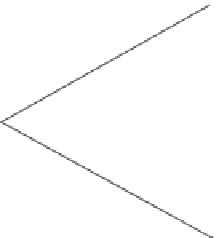Biomedical Engineering Reference
In-Depth Information
Binocular
single vision
Fragility of
binocular vision
Diplopia
Nearpoint of
convergence recovery
Nearpoint of
convergence break
FIgUre 10.16
Near point of convergence.
human eye modifies the conformation of the crystalline lens as an effect of ciliary muscle
contraction. This allows for bringing the image back onto the retina. As was mentioned
above, accommodation is strictly connected to convergence in a synergy that is used espe-
cially to compensate for some specific deficit. Accommodation can result as reduced in its
width, often because of inhibitory interferences triggered by vergence, and sometimes also
slowed down in its response. The total accommodation width available tends to increase
with age, and at approximately 40 years of age the values no longer allow for reading com-
fortably at a close distance.
10.2.2.7.1 Methods
Accommodation is also assessed with both the width and the shifting speed of the focus.
The methods of assessing the accommodation width are based on the use of negative
lenses or approaching the target to the subject. It should not be assumed that a deficiency
in accommodation width can only occur in subjects over 40 years of age with manifest
presbyopia. Our experience showed that there can also be an incidence of such cases in
children and in subjects who are not affected by neurologic or malformative diseases.
The shifting speed of the focus can similarly occur using lenses that are alternatively
positive-inhibiting/negative-excitatory or by asking the patient to read at two different
distances. In noncooperative patients, it is possible to assess if there is a sufficient accom-
modative response using retinoscopy, which objectively assesses the focus error residue
at various distances from the stimulus. The next step is then verifying how the response
changes if an object on which the attention of the patient is drawn is shifted closer or
further from the patient. Although this test is not completely accurate on a quantitative
point of view, it permits verification of the focus stability or variations when an object
is fixated.
10.2.2.8 Refraction
The eye's optical system can be affected by some focusing errors caused by a nonadequate
balance between the anterior/posterior length of the eye and the total dioptric power
because of alterations in the shape and/or in the position of the eye lenses (Saunders et al.
2010; Rossetti and Gheller 1997).












